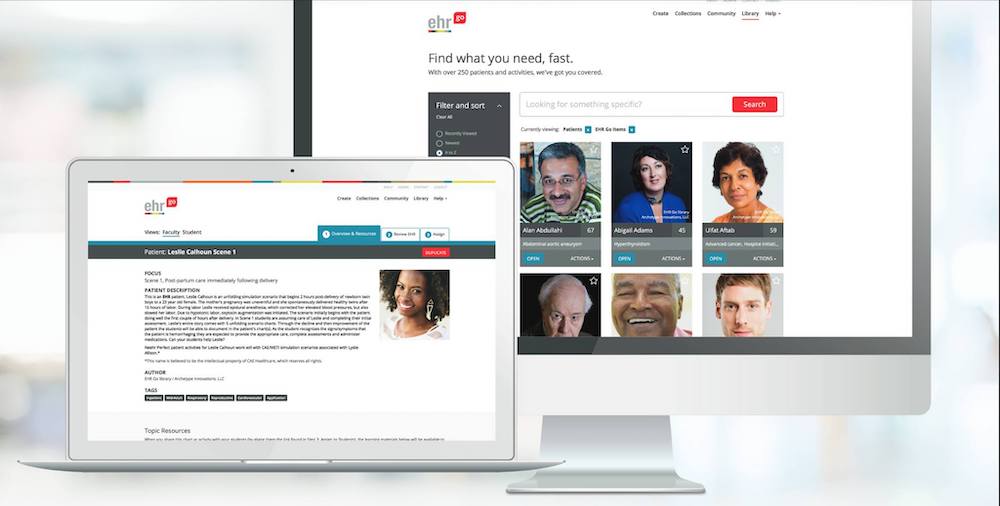Using a Simulated EHR to Bring a Human-centered Approach to Technology
EHR Go, from Archetype Innovations, enables healthcare simulation programs to provide simulated learning in the contemporary skill of electronic health record system manipulation. With over 600 customizable patient cases, its cloud based learning environment supports multiple healthcare disciplines with both face to face and virtual online clinical training, maximizing IPE training opportunities while minimizing system footprint. A crucial component for any clinical simulation program, today we take a closer look at the Go EHR platform!
Healthcare faculty are using an innovative resource that gives students more than an education, it gives them practice. With this applied teaching tool, students are no longer handed a paper case with a paragraph synopsis, but are instead are given access to a simulated medical record, through which they can read case notes, look at lab work, and piece the patient puzzle together. The considerations become as multifaceted as the patients they represent, and the material resonates with students because it circles back to why they chose to study healthcare in the first place — to help people.
This educational EHR and learning platform, called Go, is used in all disciplines of healthcare education as a hands-on teaching tool. The Go EHR includes 600+ customizable patient cases and activities built around the diverse and realistic human stories healthcare professionals see every day. It is web-based, accessible from anywhere with an internet connection, and can be used in any learning environment: face-to-face or virtual. Designed to work both within and between programs and disciplines, Go is truly interprofessional its scope.
Sponsored Content:
“A virtual grand rounds”
“It’s like a virtual grand rounds,” said Kathleen Annala, CEO and President of Archetype Innovations, LLC, creators of Go. Students work up diverse patient cases. Photographs bring patient cases to life and give students the sensation, ‘This is a real person.’ Faculty can be creative with their teaching and the platform helps them personalize care simulations.
As a professor, Annala saw her students were always looking for that human connection. She wove her experience as a nurse into her lessons, not just teaching the physiology of a burn, per se, but sharing the story of a little boy in the foster care system who got burned playing with a barbecue lighter.
“When you bring that holistic way of seeing the world into the classroom, it makes the content go from dry and clinical to a very human, understandable experience where the numbers matter because this little boy is in pain,” Annala said. “Students immediately take the case more seriously, they start engaging with the material, and when done within the Go EHR, it becomes all the more realistic.”
Sponsored Content:
Case-based learning and interprofessional education
Educational EHRs have elevated case-based learning and Annala has played a part in its progression since its conception. She moved into education early on in her nursing career and because she was young, it was presumed she was a technology whiz. Nearly 20 years ago, she was handed a project to bring a computerized electronic health record system into the curricula for healthcare students. She had the vision for Go even then, when she recognized the educational EHR should be the center of case-based learning and interprofessional education, just as a person should be the center of a case study. Learn more about EHR Go on their website!
Barriers — institutional, technological and financial — stopped Annala’s vision from fully coming to fruition while she was a teaching faculty. In 2008, she took a leap with her business partner and husband, Don Annala, to create the ultimate educational EHR, the one she originally envisioned, the one that has evolved into Go, the only educational EHR tailored to and able to fully accommodate interprofessional education.
The evolution of simulated EHRs in healthcare education
“Where EHR education began was to teach the EHR as a technology itself without cases. I think that’s the wrong direction but it’s the direction a lot of our competitors still use. I just don’t think it’s the right direction for students because it puts the focus on technology when the focus should be on patients and care,” Kathleen Annala said. “We believe the student learns the healthcare technology innately, through regular interaction with patient information. Learning course content through the EHR, the student becomes an EHR native. That’s why we created Go, to make a system that lends itself to maintaining case information, creating case information and using case information, that’s what was missing.”
Teaching with a simulated EHR to enhance patient safety
When Dr. Deepti Vyas, associate professor of pharmacy practice at the University of the Pacific, started using Go in her therapeutics courses in 2016, it revealed an issue: Her students struggled with order entry (especially when entering orders for intravenous drugs), they had difficulty selecting the correct formulation, diluents and frequency, and they did not always realize how easy it was to make a mistake. Before Go, many students were not getting any practice entering orders until after they graduated.
“From a patient safety perspective, Go has been vital for my students,” Vyas said. “Students understand if they enter medications incorrectly, there’s potential that they could cause patient harm. It’s very real to them, ‘I can make a mistake very easily. I can cause patient harm very easily. I need to think about what I’m doing before I approve an order, I need to collect all the pieces of information I need, because if I don’t, I could harm a patient.’”
Vyas also uses Go in her interprofessional education affiliations, as her pharmacy students virtually share cases with nurse practitioner students from the University of Missouri in Kansas City, working up patients and collaborating on treatments through a telehealth approach. By working across campuses, across disciplines, students gain such rich experiences that working in interprofessional teams becomes second nature in practice.
Customized content brings nuance and clinical experience into a case
Faculty can easily edit cases within the Go EHR, removing information that does not yet apply or adding nuance to enliven discussion. Faculty can write their own clinical experiences into a case, sharing personal knowledge with students in an applicable way. “We have seen many faculty further personalize the existing cases,” Kathleen Annala said. “They become prolific creators of customized content.” And faculty can reach out to the company, share what they would like to see the product do and see those changes made, sometimes that very day.
A true teaching tool, Go is crowd-sourced and community-based. Faculty feel they can take ownership of it. Students feel professional when they use it. To learn more or to schedule a personalized, online demonstration of EHR Go….
Visit the EHR Go Website Now to Learn More!
Sponsored Content:

















